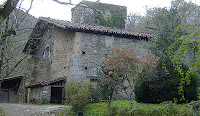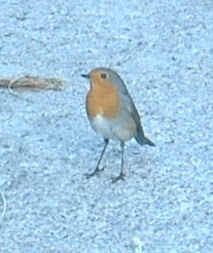Pancreas: You can't live on marzipan, you know.
Self: Fine then, we'll throw in some chocolate for balance (there is a Christmas-specific chocolate here that is wrapped in gold foil with the tag line "hecho de tus sueños" <made of your dreams> and it is kind of like a thick Nestle's Crunch bar, if Nestle's Crunches were crafted in cauldrons made of hammered narwhal tusks and mixed with diamond-coated whisks by immortal gold-crown wearing noble centaurs...which is to say the pancreas has no chance here)
Pancreas: Fine, then-won't cut out the sugar? Then chronic facial dermatitis it is, then. 
While hanging out with a friend of F's who lives in Catalunya, near Barcelona, we learned that the Catalans have a really interesting version of Santa Claus-to file under 'they do things different over there.' They make a little creature out of a log-they put a couple legs on it, with eyes and nose and a mouth-and they put a blanket on it at night and leave food for it starting around the Feast of the Immaculate Conception and continuing through the holiday season. The expectation is that it will (sorry to be crude) poop presents. Not iPads, mind you, but like, nuts and candies and such. They even have a song in which they hit the log with sticks and entreat it to poop candy, else they will hit it more. I can't imagine why this hasn't caught on elsewhere...
 So anyway yeah, it's sheep milk season here (see baby sheep), which means...mamia. This is a Basque dessert made of fermented sheep's milk-it is delicious and will send
So anyway yeah, it's sheep milk season here (see baby sheep), which means...mamia. This is a Basque dessert made of fermented sheep's milk-it is delicious and will send  you straight to naptime. Like we needed more desserts over here.
you straight to naptime. Like we needed more desserts over here.  We recently went to the local science museum, which inexplicably has probably 20 or so very detailed scale models of Basque buildings in its front yard. Kind of surreal, but neat. Otherwise I have been somewhat remiss in my photographing duties so here are some dormant sycamores outside a sagardotegia (cider house) that I see on
We recently went to the local science museum, which inexplicably has probably 20 or so very detailed scale models of Basque buildings in its front yard. Kind of surreal, but neat. Otherwise I have been somewhat remiss in my photographing duties so here are some dormant sycamores outside a sagardotegia (cider house) that I see on  my regular walk, and a couple pics from a hike we went on a while back-would you trust the water from this fountain?
my regular walk, and a couple pics from a hike we went on a while back-would you trust the water from this fountain?Wishing you and yours a most excellent
 New Year, and hope you have no nightmares now about pooping logs...
New Year, and hope you have no nightmares now about pooping logs...
















































